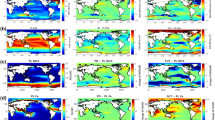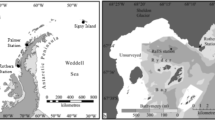Abstract
We incorporated oceanic emissions and atmospheric chemistry of dimethylsulfide (DMS) into the hemispheric Community Multiscale Air Quality model and performed annual model simulations without and with DMS chemistry. The model without DMS chemistry predicts higher concentrations of sulfate \(\left( {{\text{SO}}_{4}^{2 - } } \right)\) over land compared to the low concentrations over seawater. Including DMS chemistry substantially increases \(\left( {{\text{SO}}_{4}^{2 - } } \right)\) concentrations over seawater and many coastal areas. It enhances the annual mean surface \(\left( {{\text{SO}}_{4}^{2 - } } \right)\) by >0.8 μg/m3 in some areas of the Pacific Ocean, Atlantic Ocean, Arabian Sea, and Caribbean Sea. The largest enhancement occurs in summer in which DMS chemistry increases surface \({\text{SO}}_{4}^{2 - }\) by 70% over seawater. The model without DMS chemistry underestimates the summer-time observed \({\text{SO}}_{4}^{2 - }\) in the U.S. while the model with DMS chemistry improves model performance in the U.S. coastal areas.
Access provided by CONRICYT-eBooks. Download conference paper PDF
Similar content being viewed by others
Keywords
1 Introduction
Anthropogenic sources emit sulfur dioxide (SO2) into the atmosphere which is oxidized by gas- and aqueous-phase chemical reactions to form sulfate \(\left( {{\text{SO}}_{4}^{2 - } } \right)\). Dimethylsulfide (DMS), emitted from oceans, can undergo atmospheric reactions to produce SO2. Here, we study the annual, seasonal, and spatial impacts of DMS chemistry on \({\text{SO}}_{4}^{2 - }\) using the coupled hemispheric Community Multiscale Air Quality (CMAQ) model (Mathur et al. 2012).
2 Method
The model uses a horizontal resolution of 108 km and 44 vertical layers. Emissions and meteorological fields previously described by Sarwar et al. (2015) are also used here. Annual anthropogenic SO2 emissions of ~54 Tg are used in the model (http://edgar.jrc.ec.europa.eu/index.php). Two model simulations are performed for 2006. One simulation uses the Carbon Bond chemical mechanism (CB05) without any DMS chemistry while the other simulation uses the CB05 with DMS. Differences in the results are attributed to DMS chemistry. In CMAQ without DMS chemistry, \({\text{SO}}_{4}^{2 - }\) can be formed via oxidation of SO2 by one gas-phase reaction and five aqueous-phase reactions. DMS chemistry contains seven additional reactions (Sander 2011) (two reactions with hydroxyl radical and five reactions with nitrate, chlorine radical, chlorine monoxide, iodine monoxide, and bromine monoxide) for oxidation of DMS to SO2. DMS emissions are calculated using the monthly oceanic climatological DMS concentrations and the total resistance to gas-transfer at the air/sea interface (Lana et al. 2011). We calculate an annual DMS emissions total of 16.1 Tg for the Northern Hemisphere compared to the global annual DMS emissions total of ~28 Tg reported by Kloster et al. (2006) and Lana et al. (2011).
3 Results and Discussion
Predicted annual-mean SO2 and \({\text{SO}}_{4}^{2 - }\) over the seawater in the Northern Hemisphere without and with DMS chemistry are shown in Fig. 55.1. Predicted SO2 and \({\text{SO}}_{4}^{2 - }\) concentrations generally decrease with altitude, with DMS chemistry effectively increasing SO2 and \({\text{SO}}_{4}^{2 - }\) levels particularly near surface.
DMS chemistry enhances annual mean \({\text{SO}}_{4}^{2 - }\) over seawater by 48% compared to the simulation without DMS chemistry. It increases \({\text{SO}}_{4}^{2 - }\) by 42% in winter, 42% in spring, 70% in summer, and 43% in fall. The largest impact occurs in summer due to the combination of high DMS emission rates and high oxidant concentrations.
The spatial distribution of the predicted annual-mean surface SO2 and \({\text{SO}}_{4}^{2 - }\) concentrations are shown in Fig. 55.2. The model without DMS chemistry predicts higher concentrations of SO2 and \({\text{SO}}_{4}^{2 - }\) over land and small concentrations over seawater reflecting mainly the impact of anthropogenic SO2 sources. DMS chemistry effectively enhances SO2 and \({\text{SO}}_{4}^{2 - }\) concentrations over seawater and many coastal areas. Higher enhancements are predicted over seawater than over coastal areas. DMS chemistry enhances SO2 concentrations by >40 pptv in many oceanic areas and \({\text{SO}}_{4}^{2 - }\) levels by >0.8 μg/m3 in some areas of the Pacific Ocean, Atlantic Ocean, Arabian Sea, and Caribbean Sea.
Predicted \({\text{SO}}_{4}^{2 - }\) levels are compared to observed data from the Chemical Speciation Network (CSN) and the Interagency Monitoring of Protected Visual Environments (IMPROVE) sites in the U.S. (Fig. 55.3a). The model without DMS chemistry underestimates the summertime observed data. DMS chemistry only marginally improves the model performance when compared to observed data from all sites. However, it affects the model performance by larger margins when compared to the observed data from coastal sites (Fig. 55.3b). It improves the model performance from March to September but deteriorates the performance in other months.
4 Summary
We performed annual hemispheric CMAQ model simulations without and with DMS chemistry. The model without DMS chemistry predicts only small levels of SO2 and \({\text{S}}{\mathbf{O}}_{4}^{2 - }\) over seawater. However, DMS chemistry substantially enhances SO2 and \({\text{S}}{\mathbf{O}}_{4}^{2 - }\) over seawater and coastal areas. It enhances the annual mean surface \({\text{S}}{\mathbf{O}}_{4}^{2 - }\) concentrations by 48% compared to that obtained without DMS chemistry. It enhances summertime surface \({\text{S}}{\mathbf{O}}_{4}^{2 - }\) by the largest margin among all seasons. The model without DMS chemistry tends to under-predict \({\text{S}}{\mathbf{O}}_{4}^{2 - }\) compared to observed data in the US. DMS chemistry only marginally affects the model performance when compared to the observed data for the entire U.S. However, DMS chemistry affects model performance for \({\text{S}}{\mathbf{O}}_{4}^{2 - } \varvec{ }\) by larger margins in U.S. coastal areas.
References
Kloster S, Feichter J, Maier-Reimer E, Six KD, Stier P, Wetzel P (2006) DMS cycle in the marine ocean-atmosphere system—a global model study. Biogeosciences 3:29–51
Lana A et al (2011) An updated climatology of surface dimethylsulfide concentrations and emission fluxes in the global ocean. Global Biol Cycles, 25(1):1–17, GB1004
Mathur R, Gilliam R, Bullock OR, Roselle S, Pleim J, Wong D, Binkowski F, Streets D (2012) Extending the applicability of the community multiscale air quality model to hemispheric scales: motivation, challenges, and progress. In: Steyn DG, Trini S, (eds), Air pollution modeling and its applications XXI, The NATO science for peace and security programme, pp 175–179. Springer, Dordrecht, The Netherlands, Chapter 30
Nightingale PD, Malin G, Law CS, Watson AJ, Liss PS, Liddicoat MI, Boutin J, Upstill-Goddard RC (2000) In situ evaluation of air-sea gas exchange parameterizations using novel conservative and volatile tracers, Global Biogeochem Cy 14(1):373–387
Sander S et al (2011) Chemical kinetics and photochemical data for use in atmospheric studies, evaluation no. 17. Jet Propulsion Laboratory, Pasadena, CA, 10 June 2011
Sarwar G, Gantt B, Schwede D, Foley K, Mathur R, Saiz-Lopez A (2015) Impact of enhanced ozone deposition and halogen chemistry on tropospheric ozone over the Northern Hemisphere. Environ Sci Technol 49(15):9203–9211
Disclaimer
Although this paper has been reviewed by EPA and approved for publication, it does not necessarily reflect EPA’s policies or views.
Author information
Authors and Affiliations
Corresponding author
Editor information
Editors and Affiliations
Questions and Answers on ITM Paper No. 6.40
Questions and Answers on ITM Paper No. 6.40
1. Questioner name: Dick Derwent
Question: There is an oxidation product from the OH + DMS reaction which has a competitive fate between NO2 and O2 reactions. The NO2 route produces NO which acts as an ozone sink in high NOx environments. It would be interesting to see if a small increase in detail in the OH + DMS chemistry could produce this ozone sink along the coast of North America.
Answer: This reaction is not included in our current DMS chemistry. However, we can explore its impact in a future study.
2. Questioner name: Pavel Kishcha
Question: Could we expect any significant increase in sulfate aerosols in the future? Water temperature increases due to global warming which is followed by an increase in DMS emissions in one hand. On the other hand, anthropogenic SO2 emissions could decrease. What factor is more effective?
Answer: Anthropogenic SO2 emissions have decreased during the last 20 years and are likely to further decrease in the future. DMS emissions may increase in the future due to warmer water temperature. Thus, the relative importance of sulfate aerosols from DMS is likely to increase further in the future.
3. Questioner name: Pius Lee
Question: The enhancement plots you showed for sulfate and SO2 production from considering DMS is much stronger in the Gulf Coast than in the Pacific Coast. It looks to me that there is a strong temperature dependency. Is it as great as halogen that is roughly dependent on water temperature (exponentially)?
Answer: Inorganic halogen (iodine) emissions depend on seawater iodide concentration, atmospheric O3, and wind speed. Seawater iodide concentration has a strong dependency on seawater temperature. DMS emissions depends on seawater DMS concentration and transfer velocity. Seawater DMS concentrations are obtained from a global database and the Nightingale et al. (2000) parameterization is used to calculate transfer velocity. While both the wind speed and temperature affect transfer velocity, wind speed has a stronger influence on transfer velocity and DMS emissions.
Rights and permissions
Copyright information
© 2018 Springer International Publishing AG
About this paper
Cite this paper
Sarwar, G. et al. (2018). Dimethylsulfide Chemistry: Annual, Seasonal, and Spatial Impacts on Sulfate. In: Mensink, C., Kallos, G. (eds) Air Pollution Modeling and its Application XXV. ITM 2016. Springer Proceedings in Complexity. Springer, Cham. https://doi.org/10.1007/978-3-319-57645-9_55
Download citation
DOI: https://doi.org/10.1007/978-3-319-57645-9_55
Published:
Publisher Name: Springer, Cham
Print ISBN: 978-3-319-57644-2
Online ISBN: 978-3-319-57645-9
eBook Packages: Earth and Environmental ScienceEarth and Environmental Science (R0)







